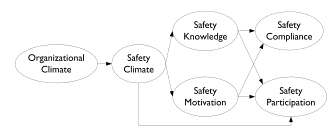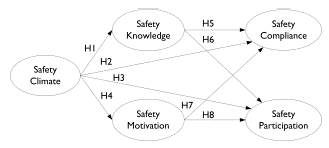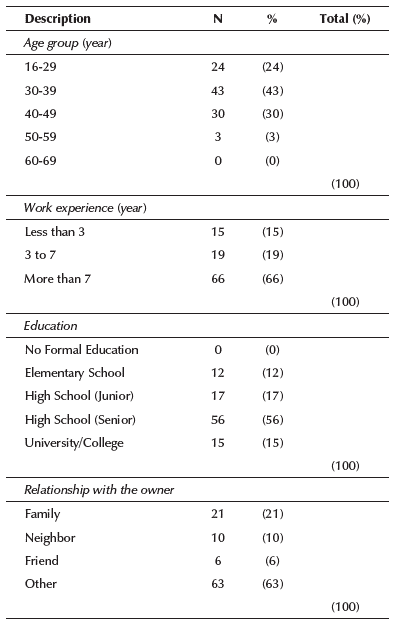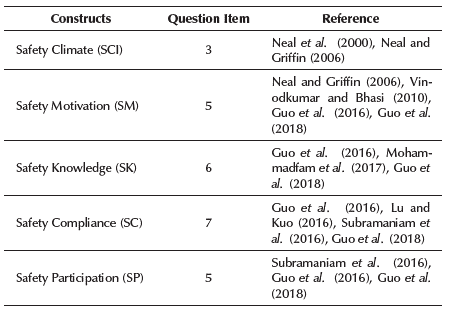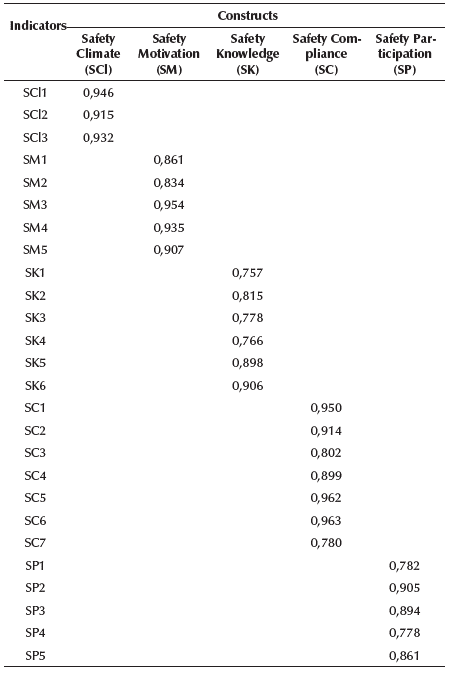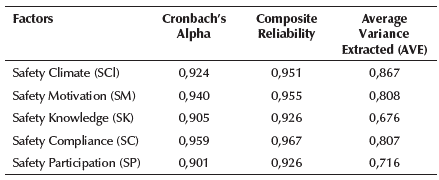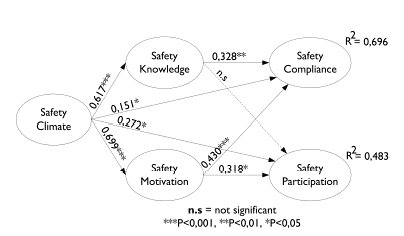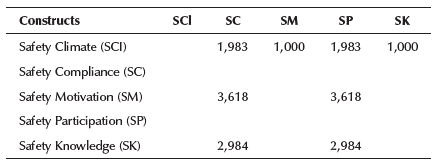Introduction
According to Geller (2001), safety behavior is an important aspect of workplace safety. Al-Hemoud and Al-Asfoor (2006) reported that 80% of accidents are triggered by unsafe behaviors, while unsafe conditions cause the remaining 20%. Khandan, Maghsoudipour, Vosoughi, and Kavousi (2013) stated that approximately 86-96% of industrial workplace accidents occur due to unsafe behaviors. Therefore, adopting an appropriate safety behavior tends to reduce the number of accidents and lost work time (Seo, Lee, Kim, and Jee, 2015). Improving in this regard is required to prevent unexpected or undesirable events (Xu and Shi, 2017), so there is a noticeably negative relation between safety behavior and accidents (Wallace, 2016).
Safety behavior reflects the safe practices that workers need to embrace to evade accidents (Panuwatwanich, Al-Haadir, and Stewart, 2016). Safety participation and compliance are generally used to describe the adopted level or extent of safety behavior (Neal, Griffin, and Hart, 2000). Safety participation is based on worker involvement, efforts, programs, and initiatives to improve workplace safety. Safety compliance refers to the state of observing established safety procedures, standards, and regulations at workplace (Neal et al., 2000).
Safety behavior can be improved by modifying its influencing factors, which are individual (person-related) and organizational (situation-related) (Christian, Bradley, Wallace, and Burke, 2009). Reports showed that organizational factors affect individual determinants, which impacts safety behavior (Neal et al., 2000). Moreover, safety training and regulations, worker participation, and supervisor support are aspects of safety climate.
There have been studies on safety behavior, but only few of them have comprehensively looked at person-related and situation-related factors in this context. Among the individual factors are safety motivation and knowledge, while organizational factors include safety climate. It should be noted that safety behavior has a direct impact on safety outcome (accidents, injury, etc.), which is influenced by both person-related and situation-related factors (Christian et al., 2009). Safety motivation is defined as the workers' eagerness to adopt safety measures in work areas (Neal and Griffin, 2006). It is an individual-level variable that is expected to be widely shared within organizational units (Kopelman, Brief, and Guzzo, 1990). Meanwhile, safety knowledge shows the level of worker awareness related to practices involved in occupational safety (Vinodkumar and Bhasi, 2010). It improves job-specific and non-job-specific task proficiencies (Campbell, McCloy, Oppler, and Sager, 1993). Results from several similar studies reported that safety motivation positively influences safety behavior (Shin, Gwak, and Lee, 2015; Amponsah-Tawaih and Adu, 2016; Panuwatwanich et al., 2016; Baser, Ture, Abubakirova, Sanlier, and Cil, 2017; Mohammadfam, Ghasemi, Kalatpour, and Moghimbeigi, 2017). Person-related factors were reported to be the key determinants that influence safety behavior.
Conversely, situation-related factors include safety climate and leadership (Christian et al., 2009). According to Neal and Griffin (2006), a safety climate is a shared awareness of procedures, wisdom, and practices related to safety in the workplace. It is an individual-level variable expected to be widely shared within organizational units (Kopelman et al., 1990). Several studies reported that safety climate influences safety behaviors (Shin et al., 2015 and Panuwatwanich et al., 2016) and is depicted by safety communication and systems, including training that influences safety behavior (Shin et al., 2015). Panuwatwanich et al. (2016) reported that safety climate is described by management commitment and communication, competence, personal appraisal of risk, work pressure, safety rules, and procedures.
More specifically, regarding Small and Medium Enterprises (SMEs), several studies showed that the dimensions of safety climate (represented by management commitment, safety training, regulations, communication, and worker involvement) have a direct effect on safety behavior (Hong, Surienty, and Hung, 2011; Saat, Subramaniam, and Shamsudin, 2016; Subramaniam, Shamsudin, Zin, Ramalu, and Hassan, 2016). This means that, in SMEs, these dimensions directly affect safety behavior. However, these studies did not include safety knowledge and motivation in their models.
SMEs have a unique safety climate, which is why their safety behavior characteristics may also be unique and influenced by the relationship between workers, as well as their relationships with their employers (owners), in order to avoid social hierarchy (Marlow and Patton, 2002; S0rensen, Hasle, and Bach, 2007; Croucher, Stumbitz, Quinlan, and Vickers, 2013), since the nature of the interaction between workers and employers during operational activities (Legg, Olsen, Laird, and Hasle, 2015) and any firm-related cordial relationships among them lead to a paternalistic culture in safety management (Croucher et al., 2013). The owners are the manager, regardless of their experiences or educational background (Croucher et al., 2013). Therefore, the safety climate that describes the workers' shared perceptions regarding a safe atmosphere is highly influenced by the owner's subjectivity. Subsequently, safety practices tend to be compromised (Kheni, Gibb, and Dainty, 2010), irrespective of whether the workers have adequate knowledge and motivation.
As a developing country, the number of accidents in Indonesia is still high, and increases have been reported during the last three years, which seems to be related to poor safety measures (Huda, Sukmawati, and Sumertajaya, 2016). In this study, we focused on metal manufacturing SMEs, which were selected due to their significant contribution to the nation's economic growth (Harncharoen, Isahak, Kaewboonchoo, Low, and Ratanasiripong, 2016). Additionally, the number of accidents that occur in this industry is quite high (Suprianto and Evendi, 2015; Ansori, Widyanti, and Sutalaksana, 2018), which is mostly due to a lack of safety behavior of the workers' part.
Safety behavior model for metal-mechanical companies was proposed by Paolillo, Silva, and Pasini (2016). Unfortunately, the study was carried out in large-scale industries. Their model showed that safety motivation mediates the relationship between safety climate and participation. Previously, Sinclair, Martin, and Sears (2008) stated that safety motivation and knowledge are the intervening factors that mediate the influence of safety climate on safety behavior. Therefore, we argue that there is an opportunity for further development of the safety behavior model, specifically for SMEs in metal manufacture. The purposes of this study were to investigate the effect of safety climate, motivation, and knowledge on safety compliance and participation in Indonesian metal manufacturing SMEs.
Conceptual Model
This study adopted the model by Neal et al. (2000), as shown in Figure 1. The model states that safety climate influences knowledge, motivation, and participation. On the other hand, it has an indirect influence on safety compliance. It should be noted that this model was developed based on a large-scale industry in Australia, and an adjustment should be made for the field under study. We hypothesized that there should be a direct effect on safety compliance, which is due to the differences between the safety climate characteristics of large industries and SMEs. Informal and personal working conditions in SMEs might lead to individual work climate (Hasle and Limborg, 2006; Perrini, Russo, and Tencati, 2007; Martin, 2012). Subsequently, the implementation of safety measures may be difficult due to the extreme flexibility of work rules (Mihail, 2004; Rothenberg et al., 2016).
Conversely, work climate is influenced by the subjectivity of workers, colleagues, and superiors or employers. Therefore, we proposed that safety climate may directly influence safety behavior in SMEs, as shown in Figure 2, which is consistent with previous studies (Hong et al., 2011; Saat et al., 2016; Subramaniam et al., 2016). The model was also adjusted based on the consideration that the cordial relationship between workers, and between them and their superiors leads to a lack of social hierarchy in SMEs (Marlow and Patton, 2002; Sorensen et al., 2007; Croucher et al., 2013). This is consistent with the study carried out by Turner, Stride, Carter, McCaughey, and Carroll (2012), which stated that safety climate (namely, decision latitude and social support) directly affects safety behavior.
Previous studies on safety behavior in SMEs indicated varying results for the effects of safety climate on compliance and participation (Subramaniam et al., 2016, Saat et al., 2016, Neal et al. 2000). We hypothesized that there should be direct effects of safety climate on safety behaviors, which is based on a study on safety behavior in small-scale industries carried out by Guo, Yiu, and Gonzalez (2018), where safety climate is represented by social support and production pressure.
The integration of person and situation-related factors in SMEs needs to be carried out due to their unique characteristics. Mihail (2004) and Rothenberg et al. (2016) stated that the safety climate of SMEs is relatively informal and personal. Subsequently, it is difficult to objectively implement safety measures, given the excessive flexibility of work rules. Furthermore, the commitment of SME management is generally based on the personality, beliefs, or values of owners-managers in order to ensure that most decisions regarding effective working conditions are their responsibility (Croucher, et al., 2013). The high level of cordial relations tends to compromise safety rules and procedures, which, in turn, can compromise occupational safety and health (OSH) implementation (Croucher, et al., 2013). Therefore, the proposed model aims to examine the direct impact of safety climates on compliance and participation.
In short, we proposed eight hypotheses, as shown in in Figure 2, namely:
H1: Safety climate positively influences safety knowledge.
H2: Safety climate positively influences safety compliance.
H3: Safety climate positively influences safety participation.
H4: Safety climate positively influences safety motivation.
H5: Safety knowledge positively influences safety compliance.
H6: Safety knowledge positively influences safety participation.
H7: Safety motivation positively influences safety compliance.
H8: Safety motivation positively influences safety participation.
Method
Respondents
This study involved 100 respondents from 23 metal SMEs with voluntary participations (mean age = 35, 40 years, SD = 7,76 years and average experience = 10,96 years, SD = 7,03 years). The sample size was considered to be sufficient according to Hair, Hult, Ringle, and Sarstedt (2017), based on the number of independent and latent variables. The demographic data of the respondents are shown in Table 1.
Questionnaire
A questionnaire was developed based on previous studies, consisting of 3 questions on safety climate (Neal et al., 2000; Neal and Griffin, 2006), 6 questions on safety knowledge (Guo, Yiu, and Gonzalez, 2016; Mohammadfam et al., 2017; Guo et al., 2018), 5 questions on safety motivation (Neal and Griffin, 2006; Vinodkumar and Bhasi, 2010; Guo et al., 2016, 2018), 7 questions on safety compliance (Guo et al., 2016; Lu and Kuo, 2016; Subramaniam et al., 2016; Guo et al., 2018), and 5 questions on safety participation (Guo et al., 2016; Subramaniam et al., 2016; Guo et al., 2018). The question items were constructed using a modified Likert scale, starting from 1 (strongly disagree) to 5 (strongly agree), as well as from 1 (never) to 6 (always), respectively, as shown in Table 2.
The questionnaire was formatted in Bahasa (Indonesian language) using a back-translation procedure, which involved three bilinguals who translated the original version to English. A comparison between the original and back-translated versions was applied to test the validity of the translation. The descriptive items or questions for each factor in the developed model are shown in Table 3.
Procedure
After obtaining permission from the owners of the SMEs, the workers were requested to answer the questionnaires. Informed consent was obtained before the respondents filled out the questionnaire, and they were assisted when they encountered any difficulties.
Data analysis
First, the validity and reliability analyses were carried out to ensure the quality of the model. Its validity was assessed using factor loading, in which the value of 0,7 or higher indicated that it was good. Second, the confirmatory factor analysis (CFA) was carried out using the Partial Least Squares Structural Equation Modeling (PLS-SEM) to ensure that the related items were grouped in a construct, in accordance with the path relation to determine their significant influences. Third, the variance inflation factor (VIF) was applied to ascertain whether there was no common method bias in the construct's collinearity statistics. Finally, the model's goodness of fit was assessed using the chi-square, and the Standardized Root Mean Square Residual (SRMR). The PLS-SEM was used to analyze the data obtained by using Smart-PLS.3 to detect abnormal distribution.
Results and Discussion
This study was aimed to evaluate the effect of situation (safety climate) and person-related factors (safety motivation and knowledge) on safety behavior (safety compliance and participation). Additionally, person-related factors served as a mediator between safety climate and behavior. The results of this study showed that safety climate was affected by safety knowledge, motivation, compliance, and participation. Subsequently, safety knowledge and motivation mediated the relationship between safety climate and behavior. Safety knowledge only affected compliance, whereas motivation tended to affect both compliance and participation. There was no common method bias among all the constructs.
The validity of our test results refers to a measurement model that was evaluated based on the loading factor shown in Table 4. Statistically, the loading factor conforms to the validity test when the outer loading has a minimum of 0,7 (Hair et al., 2017). However, most of the values obtained were greater than 0,7, which showed that the model was extremely valid. The CFA (i.e., greater than 0,757) showed that the constructs, namely safety climate, motivation, knowledge, compliance, and participation, were properly explained by the indicators.
The results from the reliability test are shown in Table 5. The Cronbach's alpha needed to be greater than 0,6, while the average variance extracted (AVE) needed to be more than 0,5, and the composite reliability had to be a minimum of 0,7 (Hair et al., 2017). All parameters met the stipulated requirements.
The empirical model is shown in Figure 3, while the results are shown in Table 6. A coefficient of determination (R2) of 0,696 and 0,483 showed that the variance in safety compliance and participation is moderately explained by the independent variables, namely, safety climate, knowledge, and motivation.
Table 6 Result of structural model
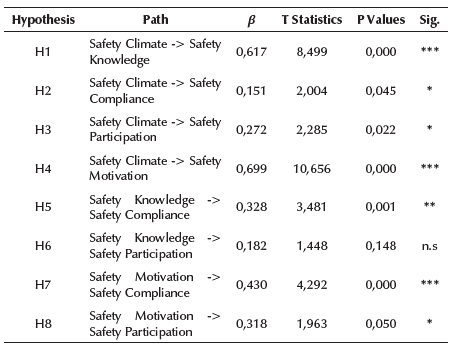
Note: β = path coefficient, ***P < 0,001, **P < 0,01, *P < 0,05, n.s = not significant
Source: Authors
We found that safety climate had a positive influence on both compliance and participation. This result is consistent with the studies carried out by Seo et al. (2015), Shin et al. (2015), and Panuwatwanich et al. (2016). The positive effect proves that an improved safe atmosphere in SMEs tends to increase the workers' compliance and participation. These results are in line with the studies carried out on SMEs in several countries, such as in Malaysia and China (Liu, Mei, and Shen, 2010; Saat et al., 2016; Subramaniam et al., 2016). Subramaniam et al. (2016) carried out detailed research on the safety climate construct based on management commitment, training, and safety regulations. Conversely, Saat et al. (2016) defined it as a form of worker involvement, training, management commitment, and communication. On the contrary, Liu et al. (2010) reported that it generally affects safety behavior. Additionally, Saat et al. (2016) and Liu et al. (2010) elaborated a systematic review of safety behavior in SME studies in Malaysia and China. Subramaniam et al. (2016) carried out an empirical study based on SME behavior in Malaysia. However, because China and Malaysia are developing countries, there is a possibility that the characteristics of their SMEs are similar to those in Indonesia. Therefore, the result from this research enriches literature centered on SMEs in developing countries.
Safety climate has a positive influence on both knowledge and motivation. This confirms that shared perceptions regarding safety procedures, policies, and practices in SMEs positively impact knowledge and motivation. This finding is consistent with the research carried out by Guo et al. (2018) regarding small-scale industries, which stated that social support and production pressure influence both knowledge and motivation as aspects of safety climate.
Furthermore, we found that safety knowledge has a positive influence on compliance. This is consistent with the studies carried out by Amponsah-Tawaih and Adu (2016) and Guo et al. (2016, 2018). However, safety knowledge did not influence safety participation. This result is different from the one obtained from the initial model developed by Neal etal. (2000), which shows that an increased understanding of safety improves compliance with safety rules and work procedures, excluding participation or involvement.
Safety motivation has a positive effect on both compliance and participation. This result is consistent with the studies carried out by Vinodkumar and Bhasi (2010), Shin et al. (2015), and Mohammadfam et al. (2017). This implies that, when the workers are motivated, they tend to be consistent with safety procedures and work settlement. Therefore, increased motivation triggers participation in terms of helping colleagues, promoting, and improving workplace safety initiatives.
Meanwhile, this study shows mediating constructs (namely, knowledge and motivation) from safety climate to safety behavior. This result is consistent with the research carried out by Sinclair et al. (2008), which stated that motivation and knowledge are the intervening factors that mediate the influence of safety climate on safety behavior.
In short, situation-related (safety climate) and person-related factors (motivation and knowledge) affect safety behavior (compliance and participation). The managerial implications of this research are to improve the safety behavior of SMEs workers through enhancing safety climate, safety motivation, and safetyknowledge. Conversely, to improve safetybehavior performance, SMEs need to consider the improvement all of them.
In the context of PLS-SEM, the common-method variance is detected through the full collinearity assessment approach (Kock, 2015). The variance inflation factor (VIF) shows the collinearity assessment. Its values need to be lower than 5. However, if it is higher, it implies a potential collinearity problem (Hair, Ringle, and Sarstedt, 2011). Table 7 shows the value of the VIF for all constructs, and all their correlation has a VIF value of less than 5, which indicates there is no common-method bias.
Finally, the goodness of fit (GoF) for the model is shown in Table 8. The chi-square is 933,598, which implies a high level of fit. Based on the research carried out by Wetzels, Odekerken-Schroder, and Oppen (2009), the chi-square started from 0,25, which is either less than, equal to, or greater than 0,36, which is presumed to be large. The standardized root means square residual (SRMR) is 0,093. However, when the SRMR is < 0,10, the model is reported to have a good fit because Henseler et al. (2014) stated that it serves as a goodness of fit measure for PLS-SEM.
Table 8 The goodness of fit (GoF)

Note: *) Based on Wetzels et al. (2009). **) Based on Henseler et al. (2014).
Source: Authors
This study has certain limitations: firstly, it has a limited number of samples, which is due to restricted permits; second, the data collection was limited to the East Java province. Further study involving more samples is therefore needed. Irrespective of its limitations, this study generally offers a valuable novel contribution in field of SMEs, particularly those in Indonesia. Moreover, this study provides empirical data on safety climate, motivation, knowledge, and relationships. The managerial implications are based on the fact that, to improve the safety behavior of SME workers, it is necessary to consider both situation-related and person-related factors.
Conclusions
Safety climate has a positive influence on knowledge, motivation, compliance, and participation. In addition, knowledge and motivation mediate the relationship between safety climate and behavior (namely, compliance and participation). Safety knowledge affects only compliance, whereas motivation affects both compliance and participation.














